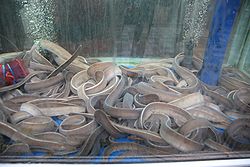| Inshore hagfish | |
|---|---|
 | |
| Inshore hagfish at the market in Busan | |
| Scientific classification | |
| Kingdom: | Animalia |
| Phylum: | Chordata |
| Infraphylum: | Agnatha |
| Superclass: | Cyclostomi |
| Class: | Myxini |
| Order: | Myxiniformes |
| Family: | Myxinidae |
| Genus: | Eptatretus |
| Species: | E. burgeri |
| Binomial name | |
| Eptatretus burgeri (Girard, 1855) | |
| Synonyms [2] [3] | |
| |
The inshore hagfish (Eptatretus burgeri) is a hagfish found in the Northwest Pacific, from the Sea of Japan and across eastern Japan to Taiwan. It has six pairs of gill pouches and gill apertures, a seventh gill aperture is closely adjacent to but separate from the pharyngocutaneous duct. [4] These hagfish are found in the sublittoral zone. They live usually buried in the bottom mud and migrate into deeper water to spawn. The inshore hagfish is the only member of the Myxinidae family having a seasonal reproductive cycle.
Contents
Generally very little is known about hagfish reproduction and embryos are difficult to obtain for study, although laboratory breeding of Eptatretus burgeri has succeeded. [5]
The hide of this hagfish is processed into "eel skin" in Korea and exported worldwide.


